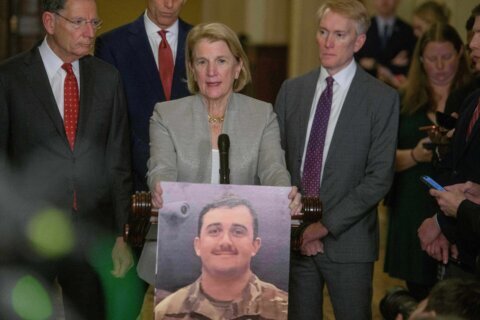
It’s been a year since artist Keyonna Jones took part in the painting of the Black Lives Matter mural on 16th Street, at what’s been officially named Black Lives Matter Plaza within sight of the White House.
Jones recalls getting a call to take part in the project, which began in the early morning hours of June 5, 2020, which came as large crowds of protesters gathered near the White House in the wake of George Floyd’s murder in Minnesota.
“I think we arrived at 3 a.m. and painted until 11,” Jones said.
Jones, an artist and founder of the Congress Heights Arts and Culture Center in D.C.’s Ward 8, said a number of participating artists opted to remain anonymous, but she did not.
“For me, I think it was really important to be seen as a Black queer woman and part of this project. Representation is really important” she said.
The project was sanctioned by D.C. Mayor Muriel Bowser, prompting some criticism from the D.C. chapter of the Black Lives Matter Global Network which called it “a performative distraction from real policy changes.”
Jones said she was aware of the criticism and said she wanted to be clear that her participation shouldn’t be seen as an endorsement of any one politician, but support for the movement.
“And it’s a lot more than just putting a mural on the ground,” she said. “It’s about being in the streets; it’s about being in community, and really showing that Black lives do matter.”
There have been concerns that the slogan has been coopted by politicians, advertisers and public figures, and that the issue that galvanized a movement has been forgotten by people who were eager to be seen as supporters.
“That’s just how the world works at times,” said Jones.
She said when society picks up on the importance of an issue, advocates need to take advantage of that moment. “And I think this is one of those times.”
Last month, D.C. transportation officials unveiled controversial plans for a more permanent version of Black Lives Matter plaza.
Jones says she sees a kinship between the Black Lives Matter movement and D.C.’s Ward 8 neighborhoods.
“We are always fighting for respect and acknowledgement” said Jones of the majority Black communities in Ward 8, where there have been decades-long struggles for housing and business investment.
Next steps for Jones includes reopening the Congress Heights Arts and Culture Center after a year that’s been “a lot,” as Jones put it.
“I’m just really excited to get back to my space where we use art as a healing tool every day, and get back to the community,” she said. “So that’s my biggest thing: get the center reopened.”
First event on the agenda: yoga.
Jones explained why this way; “To help people get back to their bodies, get back to into their meditation and their minds, and just help get people back to a healthy start. So — yoga for sure!”








